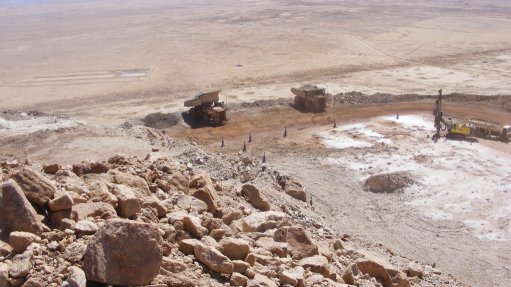
ON TRACK Vedanta has excavated more than 22.5-million tonnes of waste rock while orders for the integrated process plant, water and power and mining activities have been placed
Diversified miner Vedanta Resources’ Gamsberg zinc project, in the Northern Cape, remains on track for first production in mid-2018.
Prestart activities and waste stripping at the project have progressed well, with the completion of the north access ramp – a critical milestone and part of the openpit development – achieved on schedule. The north pit prestripping was also fully ramped up in the first quarter.
To date, Vedanta has excavated more than 22.5-million tonnes of waste rock. All major orders for the integrated process plant, water and power, mining and other prestart activities have been placed.
The manufacturing of critical machinery, such as the mills, the crusher and transformers, is progressing well. Major contractors have been mobilised to the site, where activities including civil works, power lines and water lines are under way.
The first phase of the project is expected to have a mine life of 13 years, replacing the production lost by the closure of the Lisheen mine, in Ireland, and restoring Zinc International’s volumes to more than 300 000 t/y. There is also significant potential for further optimisation at the Gamsberg North deposit.
Meanwhile, the Pit 112 extension project at the company’s Skorpion zinc mine, in Namibia, is also progressing well, with most equipment now on site. Waste mining started in April.
The extension project involves a pushback of the high wall of the existing pit and will increase the mine life from 0.5 years to 3 years. It will also increase current reserves from 900 000 t at 6.5% to 4.2-million tonnes at 9.9%.
Meanwhile, Vedanta’s Zinc International business recorded a 25% year-on-year decrease in production to 32 000 t for the quarter ended June 30 – the first quarter of its 2018 financial year.
This decrease was largely the result of a planned shutdown at the acid plant, as well as lower recoveries at Skorpion in June, the company reported last month.
Production at Skorpion during the quarter was 42% lower year-on-year and 36% lower quarter- on-quarter at 14 000 t.
Vedanta’s Zambia copper operations, however, achieved a production improvement at the Konkola underground copper mine and the Nchanga openpit, with integrated production up 9% quarter-on-quarter.
Mined metal production increased by 35% quarter-on- quarter to 20 000 t during the period, owing to improvement in equipment availability at the Konkola mine, increased throughput at the Nchanga operations and an improvement in tailings leach plant (TLP) availability.
Fleet availability at the Konkola mine further improved to 53% in the June quarter, compared with 23% in the previous quarter.
Productivity improvements at the Nchanga openpits, in addition to concentrator plant availability of 88% and TLP availability of 86%, led to integrated production of 8 000 t in June, with the trend having continued into July.
Mined metal production was, however, 30% lower year-on-year, mainly as a result of lower equipment availability at Konkola mine and TLP availability, compared with last year.
Custom volumes were 56% higher year-on-year, totalling 27 000 t, owing to improved third-party concentrate availability and the company’s ability to handle feed rates greater than 70 t/h at the smelter, following the biennial shutdown during the third quarter of the 2017 financial year.
Custom volumes, however, fell by 17% quarter-on-quarter as a result of relatively lower availability of local concentrate.
Vedanta was, however, working to optimise costs at its Zambia copper operations, Vedanta CEO Tom Albanese noted in a statement.
Vedanta further reported that Phase 1 of the elevated temperature leaching project targeted at improving TLP recoveries was being stabilised and the company was in the process of appointing an engineering consultant for Phase 2.
Meanwhile, construction of the heap leach pilot test pads is progressing well, with commissioning expected before the third quarter of the current financial year.
Additionally, preliminary proposals have been received on the cobalt project, with the identification of an offtake and technoeconomic partner through a request for a proposal-led process under way. This is expected to be completed before the third quarter of the 2018 financial year.